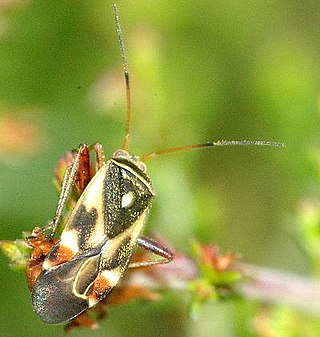
Cimicoidea is the name of a superfamily of insects belonging to the infraorder Cimicomorpha, including bedbugs and related families.
Litomiris is a genus of plant bugs in the family Miridae. There are at least three described species in Litomiris.

Polymerus is a genus of plant bugs in the family Miridae. There are at least 100 described species in Polymerus.

Tingini is a tribe of lace bugs in the family Tingidae. There are at least 250 genera and 2,400 described species in Tingini.

Acalypta parvula is a species of lace bug in the family Tingidae. It is found in Africa, Europe and Northern Asia, and North America.

Isometopinae is a subfamily of jumping tree bugs in the family Miridae and are the only members of the Miridae to possess ocelli. The subfamily is split into five tribes. There are 42 genera and approximately 239 described species in Isometopinae.
Aidoneus is a genus of lace bugs in the family Tingidae. There is at least one described species in Aidoneus, A. dissimilis.

Tingis is a genus of lace bugs in the family Tingidae. There are at least 130 described species in Tingis.
Acalypta cooleyi, or Cooley's tingid, is a species of lace bug in the family Tingidae. It is found in Europe and Northern Asia, North America, and Southern Asia.

Ceratocapsini is a tribe of plant bugs in the family Miridae. There are about 7 genera and at least 80 described species in Ceratocapsini.
Pamillia behrensii is a species of plant bug in the family Miridae. It is found in North America.

Corythucha marmorata, the chrysanthemum lace bug, is a species of lace bug in the family Tingidae. It is found in Central America and North America.

Polymerus unifasciatus is a species of plant bug in the family Miridae. It is found in Europe and Northern Asia, North America, and Southern Asia.

Macrolophus brevicornis is a species of plant bug in the family Miridae.

Microtechnites bractatus, the garden fleahopper, is a species of plant bug in the family Miridae.

Microtechnites is a genus of plant bugs in the family Miridae. There are about six described species in Microtechnites.

Halticini is a tribe of plant bugs in the family Miridae.

Neolygus is a genus of plant bugs in the family Miridae. There are at least 110 described species in Neolygus.
Nonlygus is a genus of plant bugs in the family Miridae. There is at least one described species in Nonlygus, N. nubilatus.

Restheniini is a tribe of plant bugs in the family Miridae. There are at least 4 genera and 30 described species in Restheniini.















